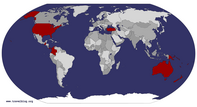Greetings to all Old Gringo fans, from Antigua, Guatemala. We snowbirds are nesting a little farther South than usual this year, in the uplands of south-central Guatemala. Years ago, in Chiapas, I said that you could see the landscape change when you cross the Rio Grijalva just before Chiapa de Corzo (in the narrowest part of Mexico, the Isthmus of Tehuantepec). There are tall wild fig trees on the banks of the Grijalva, full of monkeys eating the figs, and crocodiles waiting below for a monkey to make a mistake. No more cactus, no more of the dreary arid landscape that fills all of northern Mexico. You are quite suddenly in the Central American jungle, with plentiful water, gorgeous flowers, and vegetation so dense you can only see a few yards. This is doubly true in
... read more




